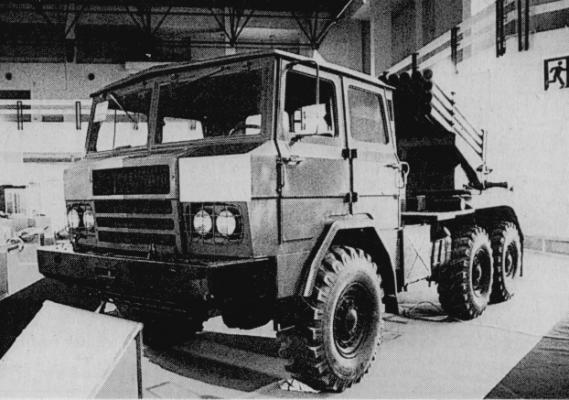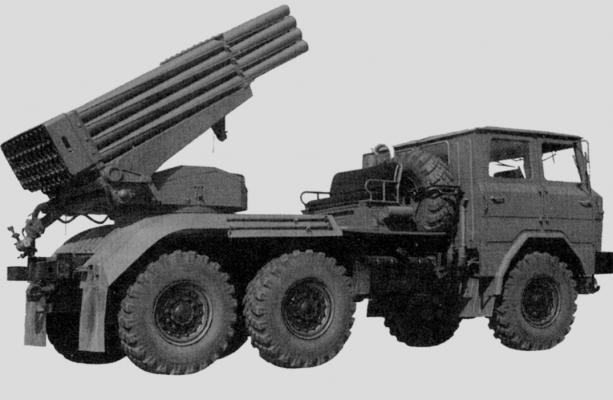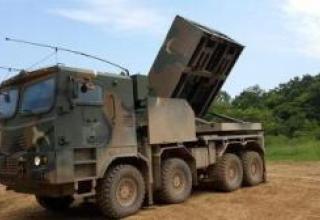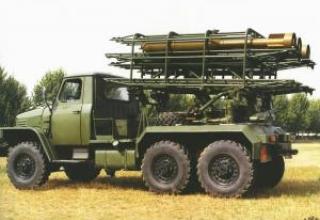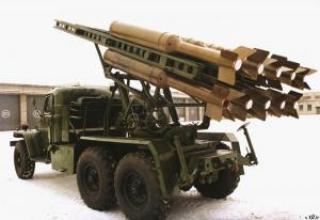The People's Liberation Army of China has a modified version of the Soviet BM-21 locally assembled fighting vehicle. It was developed by specialists of plants ¹ 743 and ¹ 5137 and became standard in 1981. It is possible that the system was created within the framework of military and technical cooperation.
The artillery unit is mounted on the modified chassis of the truck CQ261 Hongyan 6×6, which is a variant of the truck Berliet GB4, locally assembled. Later, it was mounted on a modified truck chassis of another modification. The artillery unit consists of a package of 40 tubular rails: four rows of 10 pipes each. The cabin is four-door. The length of the tubular guide rail is three meters. NURS of 122 mm caliber is used for firing, similar to that of BM-21 combat vehicle. The weight of the projectile is 66.8 kg, initial speed is 49.47 m/s, maximum range is 20,580 m.
The artillery piece can also be mounted on a special installation mounted on a modified light truck chassis or can be installed on the ground. 10-15 additional NURS are transported. The range of angles of elevation is from 0 to +55°, angle of horizontal firing - ±15°. 351 Type 81 combat vehicles were assembled. Production was carried out by specialists of Chinese military-industrial complex enterprises, NORINCO Corporation. It was replaced in production by a more efficient Type 87 system. In service with the People's Liberation Army of China and the armies of Burma (Myanmar), Cambodia, Chad, Democratic Republic of the Congo, Gabon, Ghana, Mauritania, Sri Lanka (according to 2015 and 2016, deployed by the Chadian army during the recent military conflicts in Mali and Nigeria, respectively) and possibly other countries.
Composition:
Like the entire Standard rocket family, the SM-6 rocket is designed according to the normal aerodynamic scheme and has ultra-low elongation wings and a block of all-twist opening aerodynamic rudders at the tail end.
SM-6 (see diagram) is equipped with an Mk72 solid propellant launch accelerator with a four-nozzle block. The Mk72 is equipped with a 468 kg mixture fuel charge based on polybutadiene with end hydroxyl groups (HTPB-AP). The traction vector (HTPB-AP) is controlled by the nozzle deflection. Mk104 acceleration and marching engine is a dual-mode, solid fuel. Weight of fuel charge TP-H1205/6 - 360 kg. The body is made of low-alloy steel 300M vacuum melting. The Mk72 and Mk104 engines are developed by the American company Aerojet Rocketdyne and are fully unified with the engines of the SM-3 interceptor rocket.
The SM-6 Block I control system is an inertial system with a data line, complemented by an active semi-active radar homing head (APRHSH). The AIM-120C AMRAAM is based on the homing head of the AIM-120C AMRAAM aircraft missile. The high-protected data transmission line makes it possible to receive target designation from remote radars in real time. Availability of an active APWGN channel ensures the engagement of a wide range of targets, including low-flying ones, beyond the radar coverage of the carrier ship.
The Mk125 fragmentation directional warhead is equipped with an advanced fuse and is optimized to engage low-flying targets. The Mk125 is designed by Aerojet Rocketdyne.
The rocket is launched from the MK 41 vertical launchers of the Aegis system, standard for both destroyers (Arleigh Burke class) and Aegis cruisers, and for advanced U.S. Navy ships.
Characteristics:
| Length in hiking position, mm | 7120 |
| Width in hiking position, mm | 2500 |
| Height in hiking position, mm | 3082 |
| Weight of combat vehicle in combat position, kg> | 15 160 |
| Salvo time, s | 18–20 |
| Recharging time, min | 8–10 |
| Calculation, man. | 7 |
| Number of tubular rails, pcs. | 40 |
| Guide length, mm | 3000 |
| Angle of elevation, deg: | |
| minimum | 0 |
| maximum | +55 |
| Angle of horizontal fire, deg: | |
| to the right of the chassis axle | 70 |
| to the left of the chassis axle> | 102 |
Testing:
05.09.2008 The US Navy conducted the second test of SM-6 surface-to-air missiles with over-the-horizon guidance. The missile intercepted a BQM-74 air target.
01.09.2012 In the course of the test, SM-6 was used to destroy a cruise missile target and receive designation from the JLENS system.
01.03.2013 Raytheon delivered the first SM-6 to the U.S. Navy, assembled at its new assembly and test facility in Huntsville, Alabama.
14.06.2013 The Republic of Korea has decided to begin equipping its Aegis destroyers with SM-6 anti-aircraft missiles from 2016. The decision was adopted within the South Korean government's programme on the creation of a national air and missile defence system (KAMD).
26.08.2013 The U.S. Navy fired two SM-6 anti-aircraft missiles from the USS CG-52 Chancellorsville (Ticonderoga class), which successfully intercepted two BQM-74 air targets that simulated cruise missiles.
18-20.06.2014 The USS DDG-23 John Paul Jones destroyer launched four SM-6 missiles for training purposes. One of these launches was classified as "the furthest aerial target intercept in naval history".
14.08.2014 Successful launch of SM-6 missile against a low-altitude subsonic target flying over land. The missile, launched at the command of the launch vehicle into the intended target area, independently searched and hit the target. It demonstrated the ability of the missile's ARGSN to successfully counteract interference from the underlying surface.
24.10.2014 Successful reflection of simultaneous attack of low-sonic BQM-74E and supersonic GQM-163A targets simulating anti-ship missiles. Both targets were intercepted at low altitude by SM-6 missiles launched from the USS CG-62 Chancellorsville cruiser. The launch vehicle was behind the radio-horizon, intercepted by the USS DDG 102 Sampson destroyer using SM-6 ARGSN capabilities.
28.07.2015 The US Navy successfully tested a modified version of SM-6 Dual I missile capable of intercepting ballistic targets.
18.01.2016 The SM-6 missile, launched from the USS DDG-23 destroyer John Paul Jones, hit a surface target - the decommissioned USS FFG-57 destroyer Reuben James. The test was a demonstration of the U.S. Navy's "distributed power" concept. According to this concept, it is assumed that as part of a networked ship group, some ships detect targets, others accompany them, and others strike them.
07.03.2016 The destroyer USS DDG-23 John Paul Jones successfully intercepted five targets using SM-6 SSDs, updating the maximum range record for an air target, which was set in 2014.
14.09.2016 The SM-6 missile for the first time intercepted a Zagorizon medium-sonic target using a communication channel with an F-35 fighter. The rocket was launched by the USS Desert Ship (LLS 1) launch complex equipped with the AEGIS Baseline system. The task was the last stage in a series of tests of the Naval Integrated Fire Control Counterair Network (NIFC-CA) designed to provide interaction between U.S. Navy ships and various aircraft (such as F-35 fighter aircraft) in a single integrated network. During the tests, the interceptor missile received continuous target designation from the fighter, which ensured the successful interception of the target outside the detection area of the launch complex radar.
14.12.2016 The U.S. Navy, with support from the U.S. Agency for Defense, conducted the first test of the SM-6 Dual I anti-aircraft missile to intercept a target simulating a medium-range ballistic missile. It was launched off the coast of Hawaii from a USS John Paul Jones destroyer (DDG 53) equipped with the Aegis baseline 9.C1 system. Two missiles were fired at the target.
30.08.2017 Two SM-6 Dual I interceptor missiles were launched from the USS John Paul Jones destroyer (DDG 53) against a target that simulated a medium-range ballistic missile. During the test, the target was detected, captured, escorted, and two interceptor missiles were launched. During the test, the Aegis Baseline 9.1 (BMD 5.0CU) Ballistic Missile Defense (BMD) battle control system was used.
Sources:
- Forecast International. – August 2001.
- Forecast International. – August 2011.
- Jane’s Armour and Artillery 1986-1987. – London: Jane’s Publishing Limited, 1988. – P. 741.
- Jane’s Armour and Artillery 2000-2001. – P. 767.
- http://3.bp.blogspot.com/_3wZSwFvZzqM/S5a2Ob9VJFI/AAAAAAAAF00/rn2SxEVwxcQ/s1600-h/PHZ81_1.jpg
- http://1.bp.blogspot.com/_3wZSwFvZzqM/S5a2OjBKcUI/AAAAAAAAF08/LTG4VsDDBwQ/s1600-h/PHZ81_2.jpg
- http://2.bp.blogspot.com/_3wZSwFvZzqM/S5a2PY700mI/AAAAAAAAF1E/Rtgkp5APSiU/s1600-h/PHZ81_3.jpg
- http://2.bp.blogspot.com/-Lpow3S7w5Ps/Ukdg0_4QtsI/AAAAAAAAOI4/qoN-s4hYq1Y/s1600/Mauritania+BM21.jpg
- http://beegeagle.files.wordpress.com/2011/08/army-artillery.jpg
- http://beegeagle.wordpress.com/2011/08/19/ghana-army-in-pictures/
- http://bezkompasa.ru/archives/371
- http://bmpd.livejournal.com/216108.html
- http://www.daylife.com/photo/08VK9IV4udff3
- http://www.daylife.com/photo/03Bgf7i3rD4Dp
- http://hlaoo1980.blogspot.ru/2014/03/burma-armys-mrls-or-multi-rocket.html
- http://ordendebatallainternacional.blogspot.ru/2013/05/republica-democratica-del-congo.html http://worldmilitaryintel.blogspot.ru/2013/05/blog-post_6913.html Дата копирования: 26.05.2013 года.
- http://www.bemil.chosun.com. Дата копирования фотографии: 28.02.2008 г .
- http://www.irrawaddy.org/article.php?art_id=17956
- https://twitter.com/tom_antonov/status/731112180876226560
- https://twitter.com/ToyotaWars/status/611952975444115456
- The World Defence Almanac 2008. – Р. 387.
- Фото из архива автора материала. Предположительно, действительный источник - публикация Jane's до 2005 года.
